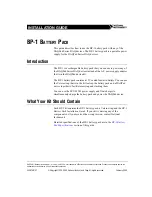
Battery charger for the PUMA T2 hand-held radio
Technical Manual
Functional Description
P/N: 779-0357/02
Revision 04
OTE Proprietary Information
Page 27
Power supply
The power supply section includes:
•
a plug protected by a delayed fuse (250 V, see the equipment plate for the
max current );
•
a 25 VA tranformer for the BCP2-850 model and a 90VA one for the BCP6-
850 model;
•
a double half-wave rectifier (BCP2-850) or a single half-wave rectifier (BCP6-
850);
•
input AC voltage 230 V, 50 Hz;
•
output
fuse;
•
output voltage 12.5 V ±1 V;
•
max output current 2 A ±0.2 A (BCP2-850); 6 A ±0.5 A (BCP6-850);
Control board
The BCP2-850 model has only one control board for the two charging slots, while
the BCP6-850 battery charger has got three of them, one for each couple of
charging slots.
On the control board there can be found:
•
a 4.5 V stabilized voltage generator, used as a circuit reference voltage;
•
a 6 V stabilized voltage generator, used for supplying the circuits;
•
one microcontroller managing all the phases of the battery
charging/discharging;
•
two indipendent charging current generators, one for each slot, directly
controlled by the microcontroller;
•
a circuit to measure the voltage levels during the charging process, controlled
by the microcontroller.
The two current generator supply a couple of charging slot.
In particular, each current generator is controlled by three microcontroller output
signals. Let’s consider, for instance, the single section relative to the upper
charging slot where two signals (“A Control” and “B Control”) control the logic port
by defining the maximum current value while the “On/Off charge” signal
enables/disables the generator.
The microcontroller output signal levels driving the current generator during the
different charging phases are shown in tab. 3.2.
Tab. 3.2:
Microcontroller output signals for the current generator
Signal
Wait
Fast charging
Slow/Maintenance charge
A control
0 V
6 V
0 V
B control
0 V
6 V
0 V
On/Off charge
6 V
0 V
0 V / 6 V square wave
















































